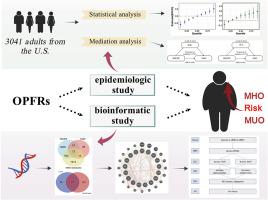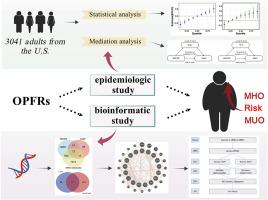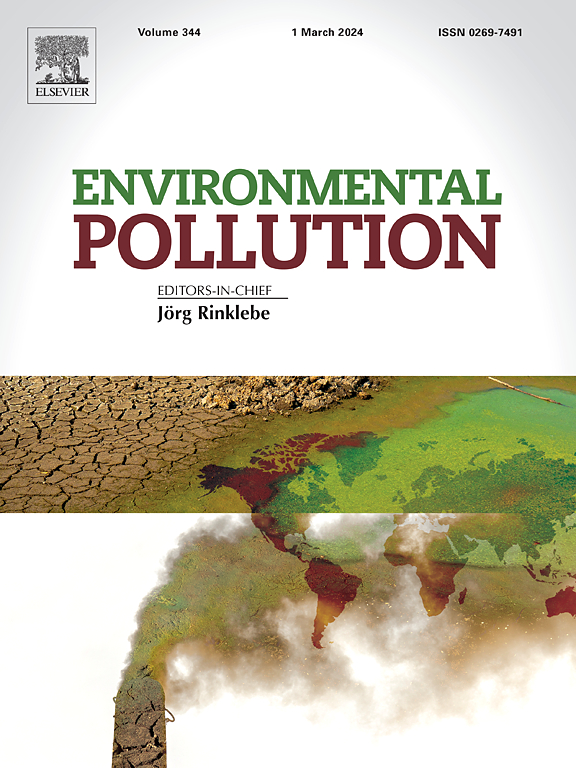氧化应激介导有机磷阻燃剂与美国成年人代谢性肥胖的关系:一项流行病学和生物信息学综合研究
IF 7.6
2区 环境科学与生态学
Q1 ENVIRONMENTAL SCIENCES
引用次数: 0
摘要
肥胖症是一个全球性的公共卫生问题,而有关有机磷阻燃剂(OPFRs)与代谢性肥胖表型(MOPs)之间的关系和机制的流行病学研究却很有限。我们旨在采用流行病学和生物信息学相结合的方法,探讨 OPFRs 代谢物(m-OPFRs)与 MOPs 之间的联系。我们利用美国国家健康与营养检查调查(2011-2018 年)的横断面调查数据分析了 m-OPFRs 与代谢健康肥胖(MHO)以及代谢不健康肥胖(MUO)之间的关系。数据集涵盖符合条件的成年人,通过多元逻辑回归、贝叶斯核机器回归(BKMR)和中介分析,评估个体效应、混合效应和中介效应对结果变量的影响。按暴露量三等分层的多元逻辑回归模型显示,与暴露量第一等分层(T1)相比,体内磷酸二(1,3-二氯-2-丙基)酯(BDCIPP)水平会显著增加罹患 MHO 的风险,第二等分层(T2)的 OR 和 95%CI 分别为 1.454(1.082,1.953)和 1.598(1.126,2.268)。与 T1 相比,T3 中 BDCIPP 水平的增加(1.452(1.013,2.081))与 MUO 有关。混合 m-OPFRs 与 BMKR 中的 MHO 风险呈正相关,而 BDCIPP 是主要因素。我们发现,血清尿酸(SUA)和白细胞计数(WBC)指标在很大程度上介导了 BDCIPP 与 MHO 之间的关联(P < 0.05)。我们的研究表明,OPFRs(单独或混合)与两种不同的澳门巴黎人娱乐官网相关,其中氧化应激起着重要作用。此外,我们还利用硅学分析筛选了共有基因,并利用筛选过程中发现的 8 个共有基因和 11 条生物通路构建了不良结局通路,这表明暴露于 OPFRs 可能会激活过氧化物酶体增殖激活受体(PPAR)通路,从而增加肥胖风险。还需要进一步的研究来验证我们的发现。本文章由计算机程序翻译,如有差异,请以英文原文为准。


Oxidative stress mediates the association of organophosphate flame retardants with metabolic obesity in U.S. adults: A combined epidemiologic and bioinformatic study
Obesity is a global public health issue, with limited epidemiologic studies on the relationship and mechanisms between organophosphate flame retardants (OPFRs) and metabolic obesity phenotypes (MOPs). We aimed to explore the link between OPFRs metabolite (m-OPFRs) and MOPs using a combined epidemiologic and bioinformatic approach. We used cross-sectional survey data from the U.S. National Health and Nutrition Examination Survey (2011–2018) to analyze the relationship between m-OPFRs and metabolic health obesity (MHO), as well as metabolic unhealthy obesity (MUO). The dataset encompasses eligible adults to assess the impact of individual, mixed, and mediated effects on the outcome variables through multivariate logistic regression, Bayesian kernel machine regression (BKMR), and mediation analysis. Multiple logistic regression models, stratified by tertiles of exposure showed that bis(1,3-dichloro-2-propyl) phosphate (BDCIPP) levels in the body significantly increased the risk of MHO, with OR and 95%CI of 1.454 (1.082, 1.953) for the second tertile (T2) and 1.598 (1.126, 2.268) for the third tertile (T3), compared to the first tertile (T1). Increased levels of BDCIPP in T3 (1.452(1.013, 2.081)) are associated with MUO, compared to T1. Mixed m-OPFRs and MHO risk in BMKR were positively correlated, with BDCIPP being the primary contributor. We found that the serum uric acid (SUA) and white blood cell count (WBC) indicators significantly mediated the association between BDCIPP and MHO (P < 0.05). Our study suggests that OPFRs, either individual or mixed, are associated with two distinct MOPs, with oxidative stress playing an important role. In addition, in silico analysis was used to screen for shared genes, and eight shared genes and eleven biological pathways identified during the screening process were used to construct the adverse outcome pathway, which suggests that exposure to OPFRs may activate the peroxisome proliferator-activated receptor (PPAR) pathway, thereby increasing the risk of obesity. Further studies are needed to validate our findings.
求助全文
通过发布文献求助,成功后即可免费获取论文全文。
去求助
来源期刊

Environmental Pollution
环境科学-环境科学
CiteScore
16.00
自引率
6.70%
发文量
2082
审稿时长
2.9 months
期刊介绍:
Environmental Pollution is an international peer-reviewed journal that publishes high-quality research papers and review articles covering all aspects of environmental pollution and its impacts on ecosystems and human health.
Subject areas include, but are not limited to:
• Sources and occurrences of pollutants that are clearly defined and measured in environmental compartments, food and food-related items, and human bodies;
• Interlinks between contaminant exposure and biological, ecological, and human health effects, including those of climate change;
• Contaminants of emerging concerns (including but not limited to antibiotic resistant microorganisms or genes, microplastics/nanoplastics, electronic wastes, light, and noise) and/or their biological, ecological, or human health effects;
• Laboratory and field studies on the remediation/mitigation of environmental pollution via new techniques and with clear links to biological, ecological, or human health effects;
• Modeling of pollution processes, patterns, or trends that is of clear environmental and/or human health interest;
• New techniques that measure and examine environmental occurrences, transport, behavior, and effects of pollutants within the environment or the laboratory, provided that they can be clearly used to address problems within regional or global environmental compartments.
 求助内容:
求助内容: 应助结果提醒方式:
应助结果提醒方式:


